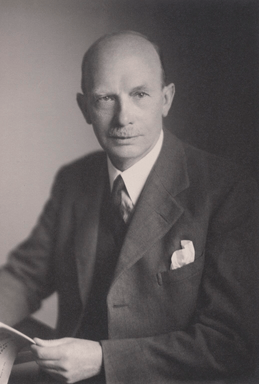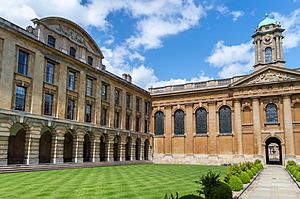Robert Howard Hodgkin facts for kids
Quick facts for kids
Robert Howard Hodgkin
FSA
|
|
|---|---|

Hodgkin in 1945
|
|
| Born | 24 April 1877 Benwell Dene, Newcastle upon Tyne, England
|
| Died | 28 June 1951 (aged 74) Shipston-on-Stour, England
|
| Education | Balliol College, Oxford |
| Occupation | Historian |
| Years active | 1900–1949 |
|
Notable work
|
A History of the Anglo-Saxons (1935) Six Centuries of an Oxford College (1949) |
| Spouse(s) |
Dorothy Forster Smith
(m. 1908) |
Robert Howard Hodgkin (born 24 April 1877 – died 28 June 1951) was an English historian. He was often called "Robin" by his family and friends. He taught history at Queen's College, Oxford, from 1900 to 1937. Later, he became the head of the college, known as its provost, from 1937 until 1946.
Hodgkin was well-known for his book A History of the Anglo-Saxons, published in 1935. He also wrote Six Centuries of an Oxford College in 1949. He was remembered as a dedicated teacher and leader. He helped guide Queen's College through the difficult years of World War II.
Contents
Robert Hodgkin's Early Life and Education
Robert Howard Hodgkin was born in Newcastle upon Tyne, England, on 24 April 1877. His family lived in a house called Benwell Dene. His father, Thomas Hodgkin, was a banker and a historian. Robert was one of seven children in his family.
The Hodgkin family was part of a group known as a "Quaker dynasty." This meant many of his relatives were successful and well-known. For example, he was related to the painter Sir Howard Hodgkin. He was also related to Thomas Hodgkin, who gave his name to Hodgkin's lymphoma. Another relative, Alan Hodgkin, won a Nobel Prize in Physiology or Medicine.
School Days and Early Challenges
When he was ten, Robert left home to attend Seabank School in Alnmouth. He spent four years there, but he was not very happy at first. His sisters later said he found school very hard. He even used to pray for the school to burn down!
Things got a little better when his younger brother, George, joined him at Seabank. After Seabank, Hodgkin went to Repton School for a short time. He was often sick, which made school even harder for him.
His doctor suggested he go to a school further south. So, he moved to Leighton Park School, a Quaker school, from 1892 to 1895. During these years, he also traveled to Italy and Austria with his father and sisters.
Studying at Oxford University
In 1896, Hodgkin began studying at Balliol College, Oxford, part of the University of Oxford. He stayed there until 1899. He made many friends, including his cousins and future important people like James Palmer, who became a bishop.
Hodgkin was a good student and enjoyed playing hockey at Balliol. He even captained the hockey team. In 1899, he earned top honors in Modern History. After leaving Oxford, he took a year off. During this time, he wrote a biography of Elizabeth Stuart, Queen of Bohemia.
Military Service and the Quakers
Despite his family's Quaker background, Hodgkin supported the Second Boer War. Quakers are known for their belief in peace. In 1900, he volunteered to serve as a lieutenant in the Royal Northumberland Fusiliers.
Because of his military service, he had to leave the Society of Friends (Quakers) in 1903. This was a difficult decision for him and his family. He later rejoined the Northumberland Fusiliers during World War I.
Robert Hodgkin's Career at Oxford
In 1900, Hodgkin was offered a job as a lecturer in modern history at Queen's College, Oxford. He became a fellow of the college in 1904. By 1910, he was also a tutor, teaching many history students.
Students remembered him as a teacher who encouraged them to explore ideas for themselves. He would "signpost the roads" but let his students "explore for themselves."
Serving in World War I
When World War I began in August 1914, Hodgkin volunteered to serve again. He rejoined the Northumberland Fusiliers as a captain. Because he was not fit for service abroad, he spent his four years of duty in coastal defense. He also worked at the War Office in London.
After the war, Hodgkin strongly supported the League of Nations Union. This organization aimed to promote peace between countries.
Returning to Queen's College

After the war, Hodgkin returned to Oxford in 1919. He found many more students at Queen's College. He became very busy with his teaching duties. He was known for being very welcoming and friendly to students.
For many years, Hodgkin worked on a big book about Anglo-Saxon England. He had first planned to write about Alfred the Great. But his research grew into a much larger project. In 1927, he took a year off to work on his book. He visited libraries and museums in Germany and Denmark.
In 1928, he became a university lecturer in modern history. He finally finished his main work, A History of the Anglo-Saxons, in 1933. The book was published in 1935.
Becoming Provost of Queen's College
From 1936 to 1937, Hodgkin temporarily served as pro-provost. This meant he filled in for the head of the college, B. H. Streeter, who was ill. His colleagues were surprised by how well he managed the college's business.
In 1937, Hodgkin planned to retire and move to a house called Crab Mill. However, just before his retirement, Streeter died in a plane crash. The college needed a new head quickly. Hodgkin was the most experienced senior fellow.
So, on 5 October 1937, Hodgkin was officially elected as the provost of Queen's College. He served for nine years, mostly during World War II.
Leading During Wartime
Hodgkin's time as provost was challenging because of the war. Many students joined the military, and parts of the college were used for wartime efforts. He also joined the local Home Guard and helped watch for enemies.
He was praised for two major achievements during his time as provost. First, he started the rebuilding of the college's grand library. It became "one of the finest buildings in Oxford." Second, he began writing a history of the college itself. He was also credited with keeping the college's traditions alive during the war.
Retirement and Later Years
Hodgkin retired for the second time in 1946. He was 68 years old. He wanted Oliver Franks to take his place. He was named an honorary fellow of the college.
He returned to Crab Mill and finished his book on the history of Queen's College. This book was published in 1949. There was a scary moment when the only copy of the book's manuscript was thought to be destroyed in a fire at the printers. Luckily, it had already been set in type, so it survived!
Robert Hodgkin's Family Life
On 6 August 1908, Robert Hodgkin proposed to Dorothy Forster Smith. She was the daughter of his former teacher at Balliol. They got married on 15 December 1908.
The Hodgkins had three children. Their first son, Thomas Lionel Hodgkin (born 1910), became a historian of Africa. In 1937, he married Dorothy Crowfoot, who later won the Nobel Prize in Chemistry. Their second son, Edward Christian Hodgkin (born 1913), became an editor for The Times newspaper.
Their younger daughter, Elizabeth (born 1915), sadly died at age eleven during an operation. This loss deeply affected both Robert and his son Edward.
Robert Hodgkin's father died in 1913. After his mother died in 1934, Robert took on more responsibility for family matters. He joked that "accounts are a nice change from Alfred," referring to his historical studies.
In November 1943, Hodgkin lost sight in one eye. He died on 28 June 1951, at his home, Crab Mill, at the age of 74. His wife, Dorothy, passed away in 1974.


